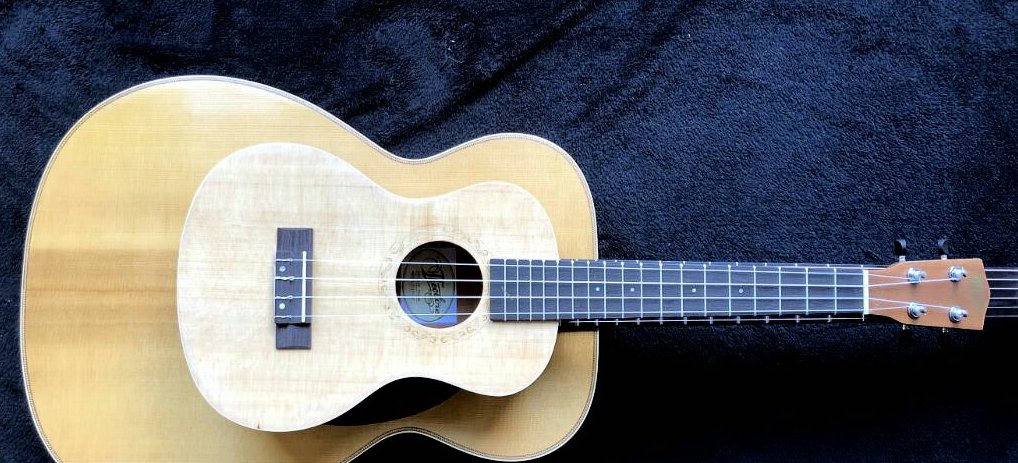The Ukulele is Not the Enemy of Your Guitar

Recently, I was laid up from surgery and under doctor's orders not to lift anything heavier than a tea kettle for a month. First off, thank you kidney stones. Secondly, doctors here in England apparently use the tea kettle as the standard unit of weight. Which gives you an idea what British doctors spend most of their free time doing.
Like any rational person, when I got home from the hospital I immediately googled, 'How much does a tea kettle weigh?' followed by a request to my wife to put my guitars on our kitchen scale.
The result showed that I needed an alternative to even my lightest parlor acoustic.
It occurred to me that maybe I should try a ukulele, as a lighter form of an at least vaguely guitar-like instrument.
Some more googling followed, this leading me to a website that said tenor ukuleles weigh somewhere south of a pound and a half. That's less than two-thirds of a tea kettle, to put it in medical terms.
So next stop, Amazon. After doing a little horizontal shopping as I lay in bed, I ordered a uke (which is what we ukulele aficionados call them, as opposed to f*cking annoying, which is what everyone else calls them). I bought a solid-spruce-top tenor model— including a gigbag that could double as a pillow case if you're not worried about damaging your pillow—for £45 (about $60.)
So, on the second day of my bed rest, the uke arrived, and I happily started plunking away. Here's what I found out initially about ukuleles:
Get The Pick Newsletter
All the latest guitar news, interviews, lessons, reviews, deals and more, direct to your inbox!
- The ratio between time spent tuning a cheap uke and playing one is around 2:1.
- They are loud. Who knew? Probably everyone who doesn't like them.
- That's pretty much all guitarists.
- They're actually good instruments for making music.
And here you have the problem. Guitarists tend to think of the ukulele as a guitar for people who can't handle more than four strings. But ukuleles are–and I am as shocked as you by this—instruments in their own right.
Moreover, because they have a lot in common with guitars yet have their own voice, they make a great addition to the guitarist's toolset.
To begin with, ukuleles have nylon strings, like a classical guitar. If you don't already have a classical guitar, a ukulele can add some high, sweet, guitar-like tones to a mix.
Ukes can take you out of ingrained musical habits by making you play and think differently while still making use of what you know from the guitar.
Plus ukuleles are small, light, cheap, and make great travel instruments.
Not counting somewhat specialist models like the baritone and sopranino, ukuleles come in three standard sizes:
- Soprano: This is the archetypal ukulele, with a 13" scale length. Unless you have the hands of a child, you might not be able to play too easily beyond first-position chords.
- Concert: The 15" scale is better but not nearly large enough for me. I know that's longer than a mandolins scale, but there's something about the nylon strings that just fights playing them on a 15" scale. Again, at least for me.
- Tenor: With the 17" scale, I can actually play barre chords and solos past the third fret. It's also louder and less plinky than the other two. And we all hate plinky.
Regardless of size, all three ukuleles are tuned to the same pitch: GCEA. You can think of this as playing the top four strings of a guitar, with a capo at the fifth fret, and the bottom string tuned an octave up. This is called re-entrant tuning.
If this is too un-guitarlike, you can always tune the fourth string to a regular G, called linear tuning, but this requires a heavier string.
Once you’ve got your uke tuned up (a normal guitar tuner works just fine for this), skip the happy strumming and learn some fingerpicked chord-melody work. Yes, the ukulele is perfectly capable of doing that. In fact, the first two songs I learned were The Beatles' "Here Comes the Sun"—because basically it already sounds and plays like a uke song—and Jake Shimabukuro's version of Leonard Cohen’s “Hallelujah.”
Move away from the "Tiptoe through the Tulips" repertoire and you'll find that there's plenty to keep a guitarist happy. Maybe not quite Tiny Tim happy, but what's good enough for George Harrison, Brian May, Eddie Vedder, Johnny Marr, Steven Tyler, Pete Townshend and moonwalker Neil Armstrong is good enough for me.
William Baeck is a writer, photographer and hack guitarist living in London. You can check out his webpage at williambaeck.com and reach him on Facebook and Twitter.
“I asked Marcus to sing on it. As amazing as he is on bass, I think he’s underrated as a vocalist”: Having earned lofty status in bass-hero circles, Marcus Miller lent his vocal chops to Hadrien Feraud’s solo album
“My brother's trying to knock Norm down in price. He's worth $800 million. He goes, ‘I'll give you a bottle of whiskey on top’”: Frank Stallone on the prized vintage Epiphone that Sylvester bought him – and the guitar's mysterious origins
"They said, 'We don't have a direction yet, but you got the gig!' I said, 'Well, let me think about it'": Yngwie Malmsteen on why he turned down UFO








![[from left] George Harrison with his Gretsch Country Gentleman, Norman Harris of Norman's Rare Guitars holds a gold-top Les Paul, John Fogerty with his legendary 1969 Rickenbacker](https://cdn.mos.cms.futurecdn.net/TuH3nuhn9etqjdn5sy4ntW.jpg)
